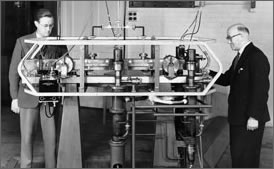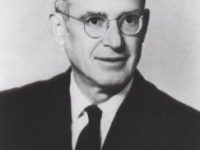
Louis Essen (1908-1997), on the left with his first atomic clock
On August 24, 1997, English physicist Louis Essen FRS, O.B.E passed away. Essen’s most notable achievements were in the precise measurement of time and the determination of the speed of light. He invented the quartz crystal ring clock and the first practical atomic clock. These devices were capable of measuring time more accurately than any previous clocks. He built a cesium-beam atomic clock, a device that ultimately changed the way time is measured.
Louis Essen – Youth and Education
Louis Essen was born in Nottingham, Nottinghamshire, United Kingdom, on September 6, 1908, as the second of three children to Fred Essen, owner of a bootmaker’s shop, and his wife Ada. Essen began his education in a local Board School in Nottingham. He graduated from High Pavement School at age 16 and entered Nottingham University College with a scholarship. Essen earned his BSc. degree in physics with first class honors from the University of London in 1928.
Research in Precise Time Measurement
Essen started work at the National Physical Laboratory (NPL) at Teddington in Middlesex the following year as a Junior Scientific Officier, under D. W. Dye, investigating the potential of tuning forks and quartz crystal oscillators for precise time measurement. His research led to his development of the quartz ring clock in 1938, which used the electrically induced vibrations of a quartz crystal to measure time.[1] Dye had already developed an annular ring oscillator which Essen later transformed by substituting circumferential for radial oscillation into a practicable standard of high stability.[2] The clock soon becoming a standard for time measurement at observatories throughout the world. It was the first device accurate enough to measure the minute variations in the Earth’s speed of rotation; prior to Essen’s work, scientists had thought that the speed was constant.[1]
World War II and Measuring the Speed of Light
During World War II, Essen worked on radar and developed a number of instruments, including the cavity resonance wavemeter. It was this work that suggested to Essen the possibility of a more precise measurement of the speed of light. In 1946, in collaboration with A.C. Gordon-Smith, he used a microwave cavity, of precisely known dimensions, and exploited his expertise in time-measurement to establish the frequency for a variety of its normal modes. As the wavelength of the modes was known from the geometry of the cavity and from electromagnetic theory, knowledge of the associated frequencies enabled a calculation of the speed of light. Their result, 299,792±3 km/s, was substantially greater than that from the prevailing sequence of optical measurements that had begun around the start of the 20th century (about 16 km/h higher[2]) and Essen had to withstand some fierce criticism and disbelief.
An Even more precise Measurement of the Speed of Light
Using improved equipment he repeated his measurement in 1950, establishing a result of 299,792.5±1 km/s. This was the value adopted by the 12th General Assembly of the Radio-Scientific Union in 1957. Most subsequent measurements have been consistent with this value. In 1983, the 17th Conférence Générale des Poids et Mesures adopted the standard value, 299,792.458 km/s for the speed of light.
The Atomic Clock
Essen earned his Ph.D. (1941) and Doctor of Science (1948) from the University of London before becoming interested in the possibility of using the frequency of atomic spectra to improve time measurement with extraordinary accuracy. The clock that he and his colleague J.V.L. Parry had developed by 1955 was regulated by the natural resonance frequency of caesium atoms. It was accurate to within one part in 10 billion (equivalent to about one second in 300 years [2]) and was the first atomic clock to meet the required standards of accuracy for such devices.[1] By 1957 they had developed an improved version of the clock that was accurate to within one part in one trillion. The extremely accurate value obtained by Essen and Parry for the frequency of the caesium atom in 1958 provided a new standard for measuring time, called atomic time, and was eventually (1967) used by the 13th Conférence Générale des Poids et Mesures to redefine the standard SI unit of time, the second, in terms of atomic frequencies.[1] Thus, finally, the basis of time measurement has switched from astronomy and the solar system to physics and the properties of the atom
Later Life
Essen spent all his working life at the National Physical Laboratory. He has been awarded the A.S. Popov Gold Medal from the USSR Academy of Sciences in 1959 as well as the Rabi Award of the IEEE Ultrasonics, Ferroelectrics, and Frequency Control Society in 1987, which make him the only scientist awarded both by the Soviet Union as well as by the USA in times of Cold War. In 1960, he became Fellow of the Royal Society. In 1971 he published The Special Theory of Relativity: A Critical Analysis, an autobiographical account of Essen’s work on Time Measurement and his controversial doubts on Albert Einstein’s special relativity, which apparently was not appreciated neither by his employers nor by the Royal Society. He retired in 1972 and died in Great Bookham, Surrey in 1997.
Anne Curtis, Timekeeping: From the Sun to the Atomic Second, [6]
References and Further Reading:
- [1] Louis Essen, British physicist, at Britannica Online
- [2] J. McA. Steele, Obituary: Louis Essen, Independent, September 3, 1997.
- [3] Alan Cook: Louis Essen, O. B. E. 6 September 1908-24 August 1997, Biographical Memoirs of Fellows of the Royal Society, Vol. 44 (Nov., 1998), pp. 142-158.
- [4] Louis Essen at Wikidata
- [5] “Time Lord” Louis Essen
- [6] Anne Curtis, Timekeeping: From the Sun to the Atomic Second, National Physical Laboratory @ youtube
- [7] Essen, L. (1978) “Relativity and Time Signals”, Electronics and Wireless World, Oct. 1978.
- [8] Essen, L.; Parry, J. V. L. (1955). “An Atomic Standard of Frequency and Time Interval: A Cæsium Resonator”. Nature. 176 (4476): 280–282





